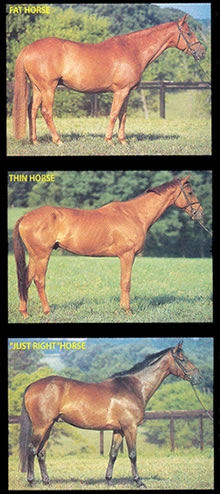If you’ve ever wanted to give your horse more traction on slick surfaces–grass, “bulletproof” hard ground, mud–studs (also called caulks) could be what you need. Long considered routine for event horses, stud can also kelp a dressage horse keep his legs under him in ten meter circles in a test on hard ground, or prevent a jumper from slipping as he accelerates through the turns of a course, be it adult-amateur, junior jumper or grand prix.

Like any tool, studs can help if they’re handled correctly and cause harm if they’re not. Using the right studs gives your horse’s feet added grip-but using more stud than he needs in a particular situation can hinder his normal stride and put him at risk of tearing a shoe off or wrenching a tendon. And wearing studs for any more time than he has to can make him sore (much the way you’d be sore if you normally wear sneakers but suddenly had to spend a day in high heels)–so always take them out as soon as you’ve finished the ride you put them in for.
Studs can cost about $1.25 to $3 a piece, but they last and last if you take care of them–I’ve had some for 15 years. They don’t need a particular kind of shoe, though with aluminum shoes you do need to be careful not to over-tighten and strip the screw threads. If you want to use studs, ask your farrier to drill stud holes in the next shoes he puts on your horse; he will probably charge an additional $10 to $15, and he may suggest clips to help hold the shoes on against the added stopping force of studs.
Suit the Stud to the Surface
As photo 2 below shows, studs come in a variety of sizes and shapes. Which kind is appropriate depends mainly on the terrain you’ll be covering, rather than the level at which you compete. (Your horse’s shoes have some bearing, too; With rim shoes, which afford a little traction of their own, he may get by with smaller studs than he’d need with flat or bar shoes.) Even if you’re not using the same kind of stud on all four shoes, you do want them all about the same height so you don’t put unequal strain on his legs.
Here’s a rundown of what’s available:
Road studs (so called because the were developed for traveling on hard-packed rods in England) come in a couple of sizes. In the container at the left on the bottom row in photo 2, the smaller square road studs give some purchase, but not quite as much as the big road studs in the same container. Flatter road studs, like those in the top left container, give just a little extra “bite” without changing the angle of the horse’s foot much.

With their pointed ends, grass tip studs, shown in the center container on the lower row, can penetrate very hard surfaces, such as ground that’s had no rain for weeks. In such conditions, many horsemen opt for the extra purchase of grass tips just on the outside of the hind feet–if they were on the inside as well, the tips could cause considerable damage should one hoof strike the other leg–and road studs elsewhere to keep the feet fairly balanced.
The somewhat rounded tips of bullet studs (at lower right in photo 2), higher than regular studs, are helpful when the going is both slippery and deep. Olympic studs (in the top right container–they’re the ones that look like nose cones for guided missiles) are the largest bullet studs; they can help feet punch through apparently bottomless mud to find a solid surface.
With any studs, even small ones, protect your horse’s legs, with tendon boots; if he gallops hard and has a big over-stride, use bell boots in front as well.

Experience is a great teacher in deciding which studs to use–so if you’re short on experience, ask a couple of veteran riders at the competition where you want to use them what they plan to run in that day. Most people don’t mind giving a little free advice on this important topic.
Photo 1. Put studs in just before you’re ready to mount your horse, as my student Mara DePuy is doing here a few minutes before pulling on her boots and starting endurance day at the 1993 Radnor International Three-Day Event–where she and Dutch Mater finished second in their division of the preliminary CCN.
Photo 2. In the light-colored bowls–actually in the bottoms of snap-lid storage dishes–an assortment of studs: (clockwise from top left) flat road studs, bullet studs and conical Olympic studs, more bullet studs, grass tips and taller road studs. Keeping studs (stored by type and size in closed containers with a little WD-40 or other lubricant in the bottom) and tools for use with them together in something like this double-level tool box ensures that everything you need for installing studs will be there when you need it.
Photo 3. To prevent dirt and pebbles from closing up the stud holes between uses, fill the holes with plugs (shown in the green lid in photo 2): either cotton, which you can treat with more WD-40 to discourage rust, or rubber. (Some people think rubber plugs stay in better; others believe cotton keeps the holes cleaner.)
When you put in studs, (wait until you are actually prepping to compete, so that your horse isn’t standing around on them longer than he hast to), start by removing the plugs–an oversize farrier’s nail works well for this–at the same time that you clean out the foot with your hoof pick.
Photo 4. Clean the threads of each hole, getting rid of any debris that might have worked its way past the plug, with a screw tap (which you can buy at a tack shop or hardware store; the hardware store taps tend to cost a little more but hold up better). Screw the tap down…
Photo 5. …just until it starts to pull the shoe away from the foot; when that happens stop immediately. If you’re having trouble getting the tap down that far, take it out, clean its threads and then try again.
Photo 6. Once the hole is clean, screw in the stud by hand as far as you can. Then finish tightening it with a vise grip just until you see no space between the bottom of the stud head and the shoe. (A vise grip works well because you can clamp it around the stud. With a horse that fidgets, though, use an adjustable wrench, you don’t want him yanking his foot away with a vice grip attached to it!)
Photo 7. The finished product: a right hind hoof with a grass tip on the outside and a road stud of similar height on the inside.
Photo 8. After your go, reverse the sequence you used to screw the studs in: Start the process with your vise grip or wrench…
Photo 9. …and when they’re loose enough remove them by hand.
In the years since this article originally appeared in the January 1994 issue of Practical Horseman, Mara Depuy, who demonstrated the use of studs for us, took her Young Rider horse Hopper all the way to the 1996 Olympics. More recently, she was short-listed for the U.S. eventing squad with her newest competition partner, Good Stuff. Mara hopes that she and Good Stuff will be selected to represent the U.S. at the Beijing Olympics in 2008.
Wash Bishop, meanwhile, rode as a member of the 1995 European Championship squad and was short-listed for the 1996 Olympics. Many of his students have represented the U.S. and Canada at Olympic Games, Pan Am Games and World Championships. He has also been a
selector for the U.S. Equestrian Team and a member of the (then) American Horse Shows Association (now the U.S. Equestrian Federation).
Find out what other equipment you and your horse need to be ready for eventing’s three phases in the October 2006 issue of Practical Horseman.










